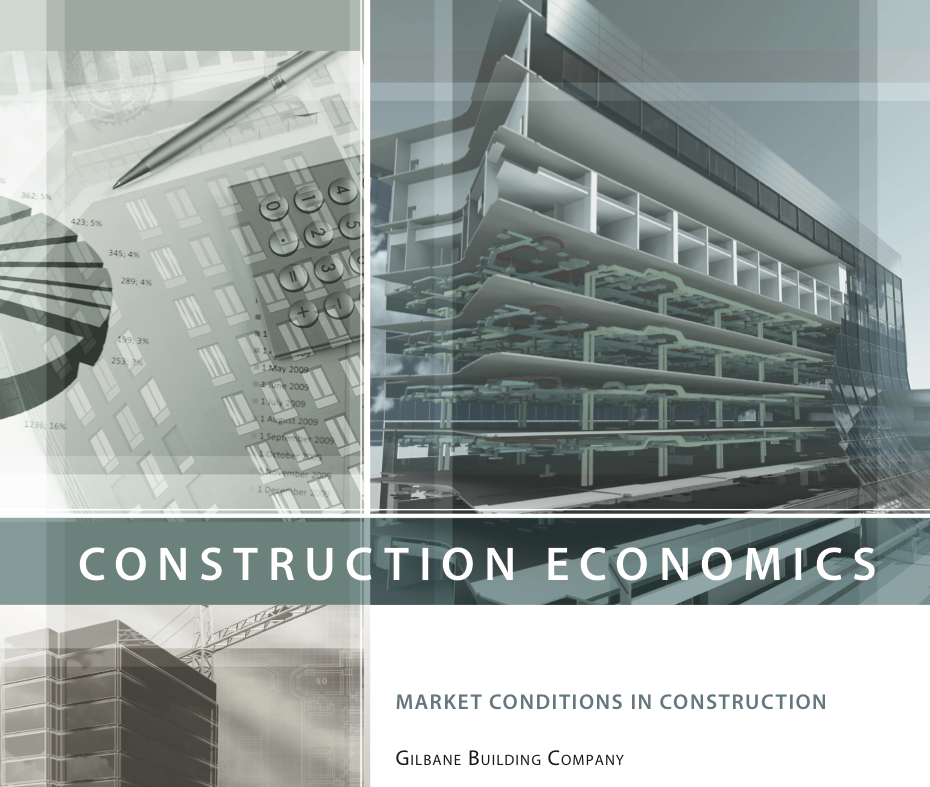The construction sector in the nine states with 50% of construction employment was up 169,000 jobs from February to September 2012, following a lost of 137,000 jobs from September 2011 to January 2012.
That’s one of the key findings of “Construction Economics: Market Conditions in Construction” (November 2012), by Gilbane Building Co., Providence, R.I. The construction management giant found several others reasons to report that construction growth was looking up:
- Construction spending for nonresidential buildings should be up 4.9% in 2012 over 2011, to $297 billion. Residential should be up 12% YOY, putting total building construction ahead 8% for the year.
- Construction starts are increasing at a slow but upward rate, while backlog duration is also increasing. As a result, contractors are feeling somewhat more comfortable passing along material cost increases.
- Overall construction spending for 2013 should be up another 4.9%, with residential building dollars up 11%.
- Top sectors: healthcare and education, accounting for 40% of nonresidential building spending.
The Gilbane report drops the other shoe with several negative findings. For one, publicly funded work will likely be down in 2013 due to the paucity of bond issues passed in the November election period: about $30 billion, compared to more than $60 billion in 2008.
Moreover, spending on public construction has declined 5% YOY and was expected to finish 2012 12% below the 2009 peak. The Gilbane report forecasts a further drop in public construction in 2013, for the fourth consecutive year.
And while there has been some recent hiring, the construction workforce has lost 2.25 million, or 29%, in recent years. “It will be many years before the entire workforce grows back to its previous level,” the Gilbane report says.
More info: info.gilbaneco.com/Portals/160261/docs/economicreportwinter2012.pdf. +
Related Stories
| Oct 15, 2014
Harvard launches ‘design-centric’ center for green buildings and cities
The impetus behind Harvard's Center for Green Buildings and Cities is what the design school’s dean, Mohsen Mostafavi, describes as a “rapidly urbanizing global economy,” in which cities are building new structures “on a massive scale.”
| Oct 15, 2014
Final touches make 432 Park Avenue tower second tallest in New York City
Concrete has been poured for the final floors of the residential high-rise at 432 Park Avenue in New York City, making it the city’s second-tallest building and the tallest residential tower in the Western Hemisphere.
| Oct 14, 2014
Slash energy consumption in data centers with liquid-based ‘immersive-cooling’ technology
A new technology promises to push the limits of data center energy efficiency by using liquid instead of air to cool the servers.
Sponsored | | Oct 14, 2014
3 color trends drive new commercial exterior color collections
Collectively as a society, we help create color trends, which shape our businesses, recreational facilities, healthcare centers, and civic buildings. These iconic colors are now appearing in Valspar's new color collections. SPONSORED CONTENT
| Oct 14, 2014
Get inspired with the top 10 TED talks about cities
The TED talks, none of which are longer than 20 minutes, feature speakers such as architect Moshe Safdie, Rio de Janeiro Major Eduardo Paes, and animal behaviorist Amanda Burden.
| Oct 14, 2014
Proven 6-step approach to treating historic windows
This course provides step-by-step prescriptive advice to architects, engineers, and contractors on when it makes sense to repair or rehabilitate existing windows, and when they should advise their building owner clients to consider replacement.
| Oct 14, 2014
Richard Meier unveils design for his first tower in Taiwan
Taiwan will soon have its first Richard Meier building, a 535-foot apartment tower in Taichung City, the country’s third-largest city.
| Oct 13, 2014
The mindful workplace: How employees can manage stress at the office
I have spent the last several months writing about healthy workplaces. My research lately has focused on stress—how we get stressed and ways to manage it through meditation and other mindful practices, writes HOK's Leigh Stringer.
| Oct 13, 2014
Debunking the 5 myths of health data and sustainable design
The path to more extensive use of health data in green building is blocked by certain myths that have to be debunked before such data can be successfully incorporated into the project delivery process.
Sponsored | | Oct 13, 2014
The problem with being a customer-centric organization
Kristof De Wulf, CEO of InSites Consulting, argues that the effects of customer-centricity typically don’t endure, leading only to temporary improvements in company performance. SPONSORED CONTENT

















